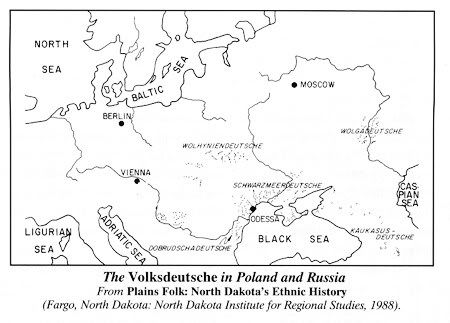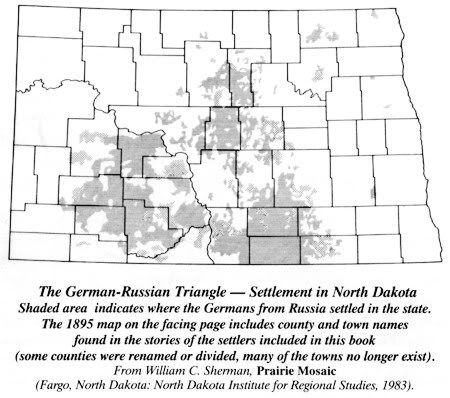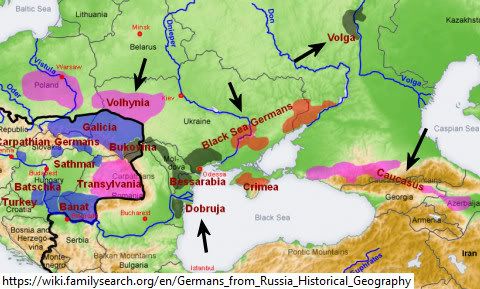Previously: Native Americans
Notes from:
The Way It Was
The North Dakota Frontier Experience
Book Four: Germans from Russia Settlers c. 1999
By Everett C. Albers and D. Jerome Tweton, Editors
Introductory Section:
In Search of a Better Life: The Germans From Russia, by D. Jerome Tweton
“Der Erste hat den Tod,
Der Zweite hat die Not,
Der Dritte erst hat Brot.”
“For the first generation, there is death.
For the second, there is want.
Only for the third is there bread.”
—Black Sea German proverb
Why were there Germans in Russia?
Because Catherine The Great (German royal ancestry) Russian Ruler 1762-1796 offered them:
a. free land
b. exemption from service in the Russian army
c. religious freedom
d. local self-government
e. and tax exemption
to come on over to southern Russia and develop the lower Volga River and Black Sea regions.

Black Sea area is now southern Ukraine. Muldova borders Ukraine.
Bessarabia Map
Europe
Why did they leave Russia?
Well, everything went fairly well until Tsar Alexander II (1855-1881) came along and started taking away what Catherine The Great had offered. Then Tsar Alexander III (1881-1894) was even worse. He decided the Germans from Russia must be "Russianized" or assimilated into mainstream society.
Assimilate!
Besides the political situation, there was also land shortage and economic distress.
Why North Dakota?
They came to the US to farm and land scouts determined the best unclaimed land was in the Dakota Territory. They started in what is now called South Dakota and by 1884 had pushed up into North Dakota area.

How much land are we talking about?
I hadn't realized these were large chunks of land.
In Book One of the series, Sod-Busters, it says:
People learned how to use the land laws to their advantage. One could parlay the Preemption Act, the Homestead Act, and the Timber Culture Act (plant those trees!) into 480 acres (160x3=480).
160-acre preemption cost $1.25 an acre.
The most common combination was a homestead and tree claim for a total of 320 acres.
Sometimes unmarried couples would file on adjoining quarters of land and then marry afterward, giving them a 320-acre farm.
A father and four sons of legal age could homestead adjoining quarters forming an 800-acre farm (5x160=800).
Back to Book Four.
Now the part that got a little confusing to me was differentiating among various groups of Germans from Russia.
The above group as a whole is referred to as Black Sea Germans.
The Volga Germans were the first immigrants to leave Germany for Russia in the 1760s.
(immigrants - to vs emigrants - from)
Tweton further divides with:
Germans from the Caucasus region
Dobrudja Black Sea Germans (to ND via Canada)
German-Russian Mennonites
Volhynian Germans
Tweton says the Volga, Caucasus and Volhynian Germans never came in great numbers to North Dakota.
The point being that this was a diverse group. They came from different parts of the Russian Empire, spoke different German dialects, and had different religious backgrounds as well. They had a strong loyalty to their particular village/region.
This visual helped:

I added the arrows and cropped to fit my blog.
The time frame wasn't readily apparent to me at first either. I wasn't aware that Germans were moving to Russia over a long period of time, from the 1760s til 1850s? I'm still not sure how that all happened. Also, I think the Germans sometimes didn't come directly from Germany to Russia. Didn't some migrate after the Napoleonic wars to other areas like Poland? I'm not sure of the geography back then.
So are the different German dialects a lot different from each other? I don't know.
The only thing I know in German are swear words.
Donnerwetter noch einmal!
lol
I think the usual route to America was to take a train to Germany, probably a seaport like Hamburg, and then take a ship to New York. After that they took a train again, I think. Sometimes part of the journey within the US was by covered wagon.
Travel Routes for Germans leaving Russia to North America.
A Brief History of the Germans from Russia
says
First the colonists settled along the Volga River from 1764 to 1767.
Then later as Russia acquired Ukrainian lands north of the Black Sea and the Crimean Peninsula and Bessarabia, the colonists also settled in these areas as well.
[Article note: Bette's first name is Johann; his middle name is Ludvig.]

1 comment:
This was helpful for research I am conducting on the history of settlers in ND - Thanks. I'll look for the original sources based on your materials.
Post a Comment